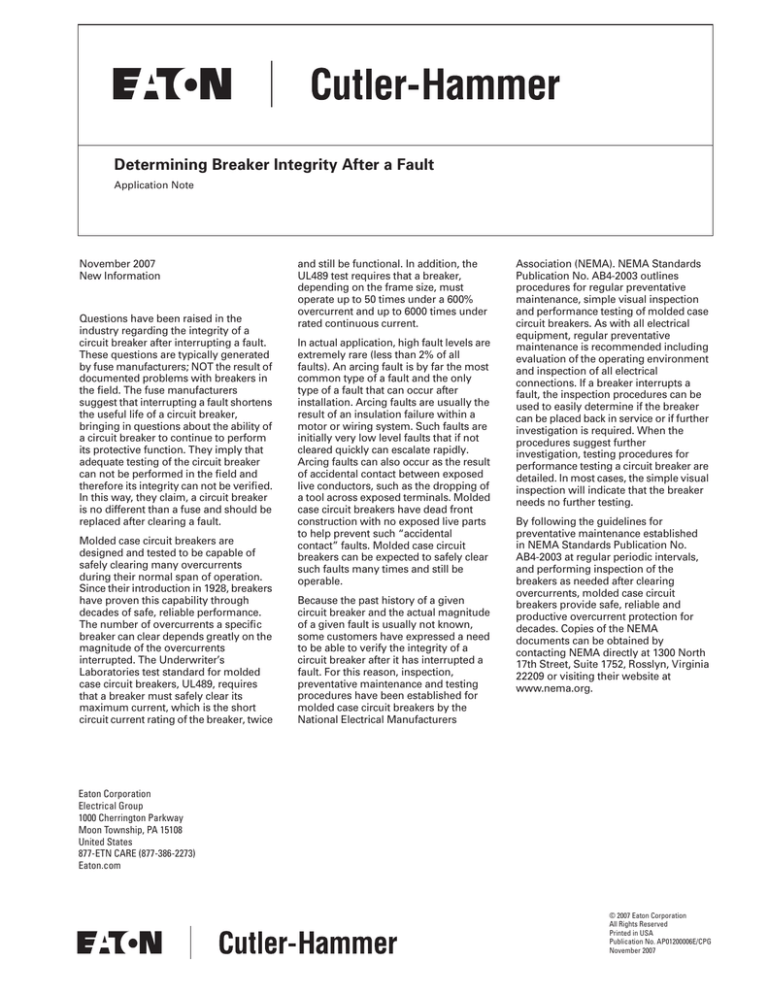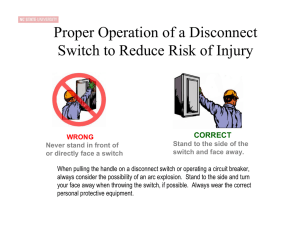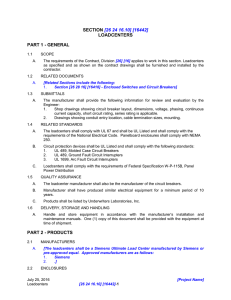
Determining Breaker Integrity After a Fault
Application Note
November 2007
New Information
Questions have been raised in the
industry regarding the integrity of a
circuit breaker after interrupting a fault.
These questions are typically generated
by fuse manufacturers; NOT the result of
documented problems with breakers in
the field. The fuse manufacturers
suggest that interrupting a fault shortens
the useful life of a circuit breaker,
bringing in questions about the ability of
a circuit breaker to continue to perform
its protective function. They imply that
adequate testing of the circuit breaker
can not be performed in the field and
therefore its integrity can not be verified.
In this way, they claim, a circuit breaker
is no different than a fuse and should be
replaced after clearing a fault.
Molded case circuit breakers are
designed and tested to be capable of
safely clearing many overcurrents
during their normal span of operation.
Since their introduction in 1928, breakers
have proven this capability through
decades of safe, reliable performance.
The number of overcurrents a specific
breaker can clear depends greatly on the
magnitude of the overcurrents
interrupted. The Underwriter’s
Laboratories test standard for molded
case circuit breakers, UL489, requires
that a breaker must safely clear its
maximum current, which is the short
circuit current rating of the breaker, twice
and still be functional. In addition, the
UL489 test requires that a breaker,
depending on the frame size, must
operate up to 50 times under a 600%
overcurrent and up to 6000 times under
rated continuous current.
In actual application, high fault levels are
extremely rare (less than 2% of all
faults). An arcing fault is by far the most
common type of a fault and the only
type of a fault that can occur after
installation. Arcing faults are usually the
result of an insulation failure within a
motor or wiring system. Such faults are
initially very low level faults that if not
cleared quickly can escalate rapidly.
Arcing faults can also occur as the result
of accidental contact between exposed
live conductors, such as the dropping of
a tool across exposed terminals. Molded
case circuit breakers have dead front
construction with no exposed live parts
to help prevent such “accidental
contact” faults. Molded case circuit
breakers can be expected to safely clear
such faults many times and still be
operable.
Because the past history of a given
circuit breaker and the actual magnitude
of a given fault is usually not known,
some customers have expressed a need
to be able to verify the integrity of a
circuit breaker after it has interrupted a
fault. For this reason, inspection,
preventative maintenance and testing
procedures have been established for
molded case circuit breakers by the
National Electrical Manufacturers
Association (NEMA). NEMA Standards
Publication No. AB4-2003 outlines
procedures for regular preventative
maintenance, simple visual inspection
and performance testing of molded case
circuit breakers. As with all electrical
equipment, regular preventative
maintenance is recommended including
evaluation of the operating environment
and inspection of all electrical
connections. If a breaker interrupts a
fault, the inspection procedures can be
used to easily determine if the breaker
can be placed back in service or if further
investigation is required. When the
procedures suggest further
investigation, testing procedures for
performance testing a circuit breaker are
detailed. In most cases, the simple visual
inspection will indicate that the breaker
needs no further testing.
By following the guidelines for
preventative maintenance established
in NEMA Standards Publication No.
AB4-2003 at regular periodic intervals,
and performing inspection of the
breakers as needed after clearing
overcurrents, molded case circuit
breakers provide safe, reliable and
productive overcurrent protection for
decades. Copies of the NEMA
documents can be obtained by
contacting NEMA directly at 1300 North
17th Street, Suite 1752, Rosslyn, Virginia
22209 or visiting their website at
www.nema.org.
Eaton Corporation
Electrical Group
1000 Cherrington Parkway
Moon Township, PA 15108
United States
877-ETN CARE (877-386-2273)
Eaton.com
© 2007 Eaton Corporation
All Rights Reserved
Printed in USA
Publication No. AP01200006E/CPG
November 2007





